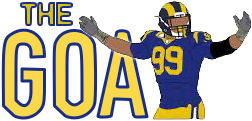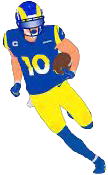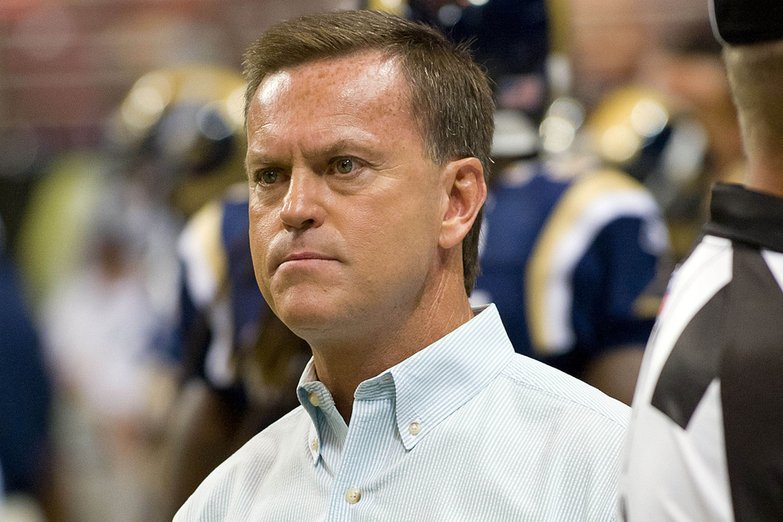- Joined
- Jun 28, 2010
- Messages
- 49,214
- Name
- Burger man

<a class="postlink" href="http://espn.go.com/nfl/story/_/id/9309332/the-2009-draft-class-vanishing-teams-picked-it" onclick="window.open(this.href);return false;">http://espn.go.com/nfl/story/_/id/93093 ... -picked-it</a>
Michael Crabtree's Achilles tendon tear couldn't have come at a worse time for the San Francisco 49ers. It also comes at a bad time for the draft class of 2009.
Slowly but surely, the players in the class of 2009 are vanishing from the teams that drafted them. With the one-year contract the New York Giants gave former third-round wide receiver Ramses Barden, only 60 members of the 2009 class are still with their original teams. That number could drop significantly next year because 33 of them are potential free agents.
Free agency normally gobbles up a good portion of draftees once rookie contracts expire, but the key to building any franchise is retaining good draft choices. Unless something changes, the 2009 draft will be considered a crack in the building process for most teams. That's why the timing of Crabtree's injury is so critical. This year is the final year of his contract, and the 49ers face an important decision involving his future. It took Crabtree until the second half of last season to emerge as the No. 1 receiving threat the team thought he would be when it took him with the 10th overall pick in '09.
Do the Niners pay him between $9 million and $12 million a year, franchise him for a year, or let him hit the free-agent market?
San Francisco already is $5 million over next year's salary cap and is maxed out in terms of high-priced players on a Super Bowl-caliber roster, it wasn't a given Crabtree would have gotten that money even if he were healthy.
Michael Crabtree is one of the relatively few 2009 draftees with his original team, but he's injured and his future is in doubt.
Crabtree could be back as early as November, but he probably won't be at the No. 1-receiver level any time this season. Had he been healthy, it would have been much easier to give him the extension.
Many other 2009 draftees are facing the same kind of evaluations, and there is a good chance many will be on new rosters next year. The 2009 draft has already been looked at as a disappointment for the past couple of years. Four of the top 11 picks -- tackle Jason Smith, linebacker Aaron Curry, wide receiver Darrius Heyward-Bey, defensive lineman Aaron Maybin -- are no longer with the teams that drafted them.
Smith, Curry and Maybin are making the NFL minimum with their new teams. Mark Sanchez, the fifth pick in the 2009 draft, has his New York Jets career on life support. If Sanchez does make the roster this year, it's almost guaranteed he won't be back in 2014. Defensive end Tyson Jackson, the third pick in the 2009 draft, has had to take pay cuts from his rookie contract the past two years to stay with the Kansas City Chiefs. He's a free agent next year.
It's like that up and down the list of first-rounders from 2009. Jacksonville Jaguars left tackle Eugene Monroe is in the final year of his deal, but the Jags made a future left tackle, Luke Joeckel, the second pick in this year's draft. Can they afford to pay two tackles? Debatable. Right tackle Andre Smith of the Cincinnati Bengals and linebacker Clay Matthews of the Green Bay Packers are the only 2009 first-rounders who received big contract extensions with the teams that drafted them and figure to keep the money. Sanchez was rewarded, but his deal has given the Jets cap problems and he won't play out that contract in New York. This is the fifth year in the league for the '09 class, and its members' franchises aren't totally on board with locking many of them up long term.
The Tampa Bay Buccaneers will use the upcoming season to see whether quarterback Josh Freeman is worth big money. Decisions have to be made about wide receivers Kenny Britt of the Tennessee Titans and Hakeem Nicks of the New York Giants. Because the Packers paid big money for Matthews and quarterback Aaron Rodgers, defensive tackle B.J. Raji will have to see how much money is left for him, and Raji might leave after the season. The New Orleans Saints know safety Malcolm Jenkins is a good player, but how much will they be able to pay him after drafting safety Kenny Vaccaro in the first round?
The only first-rounders from 2009 who are assured of getting big deals are linebacker Brian Cushing of the Houston Texans and quarterback Matthew Stafford of the Detroit Lions. Despite injuries, Cushing is one of the leaders on Houston's defense.
Centers Alex Mack of the Cleveland Browns and Eric Wood of the Buffalo Bills also have a good chance to get long-term security with their teams. Everything else is uncertain. The Baltimore Ravens drafted Michael Oher to be their left tackle for the next decade, but they have him at right tackle at this point. Wide receiver Jeremy Maclin has been a success story for the Philadelphia Eagles, but will he get a big deal with the team having just paid out for fellow wideout DeSean Jackson? Sure, the 2009 draft class has its successes. Defensive lineman Michael Johnson of the Bengals, safety Jairus Byrd of the Bills and defensive tackle Henry Melton of the Bears were designated franchise players. A good crop of young tackles also emerged: Andre Smith, Phil Loadholt of the Minnesota Vikings, Sebastian Vollmer of the New England Patriots and William Beatty of the New York Giants. Running back LeSean McCoy of the Philadelphia Eagles has been a star, and safety William Moore of the Atlanta Falcons established himself as a Pro Bowler. Still, it's possible there might be as few as 35 to 40 holdovers from the 2009 draft with their original teams. That's horrible.
Already, the Dallas Cowboys and Oakland Raiders are without any of the players they drafted in 2009, and they won't be alone for long.
The class of 2009 is pulling a vanishing act.
Michael Crabtree's Achilles tendon tear couldn't have come at a worse time for the San Francisco 49ers. It also comes at a bad time for the draft class of 2009.
Slowly but surely, the players in the class of 2009 are vanishing from the teams that drafted them. With the one-year contract the New York Giants gave former third-round wide receiver Ramses Barden, only 60 members of the 2009 class are still with their original teams. That number could drop significantly next year because 33 of them are potential free agents.
Free agency normally gobbles up a good portion of draftees once rookie contracts expire, but the key to building any franchise is retaining good draft choices. Unless something changes, the 2009 draft will be considered a crack in the building process for most teams. That's why the timing of Crabtree's injury is so critical. This year is the final year of his contract, and the 49ers face an important decision involving his future. It took Crabtree until the second half of last season to emerge as the No. 1 receiving threat the team thought he would be when it took him with the 10th overall pick in '09.
Do the Niners pay him between $9 million and $12 million a year, franchise him for a year, or let him hit the free-agent market?
San Francisco already is $5 million over next year's salary cap and is maxed out in terms of high-priced players on a Super Bowl-caliber roster, it wasn't a given Crabtree would have gotten that money even if he were healthy.
Michael Crabtree is one of the relatively few 2009 draftees with his original team, but he's injured and his future is in doubt.
Crabtree could be back as early as November, but he probably won't be at the No. 1-receiver level any time this season. Had he been healthy, it would have been much easier to give him the extension.
Many other 2009 draftees are facing the same kind of evaluations, and there is a good chance many will be on new rosters next year. The 2009 draft has already been looked at as a disappointment for the past couple of years. Four of the top 11 picks -- tackle Jason Smith, linebacker Aaron Curry, wide receiver Darrius Heyward-Bey, defensive lineman Aaron Maybin -- are no longer with the teams that drafted them.
Smith, Curry and Maybin are making the NFL minimum with their new teams. Mark Sanchez, the fifth pick in the 2009 draft, has his New York Jets career on life support. If Sanchez does make the roster this year, it's almost guaranteed he won't be back in 2014. Defensive end Tyson Jackson, the third pick in the 2009 draft, has had to take pay cuts from his rookie contract the past two years to stay with the Kansas City Chiefs. He's a free agent next year.
It's like that up and down the list of first-rounders from 2009. Jacksonville Jaguars left tackle Eugene Monroe is in the final year of his deal, but the Jags made a future left tackle, Luke Joeckel, the second pick in this year's draft. Can they afford to pay two tackles? Debatable. Right tackle Andre Smith of the Cincinnati Bengals and linebacker Clay Matthews of the Green Bay Packers are the only 2009 first-rounders who received big contract extensions with the teams that drafted them and figure to keep the money. Sanchez was rewarded, but his deal has given the Jets cap problems and he won't play out that contract in New York. This is the fifth year in the league for the '09 class, and its members' franchises aren't totally on board with locking many of them up long term.
The Tampa Bay Buccaneers will use the upcoming season to see whether quarterback Josh Freeman is worth big money. Decisions have to be made about wide receivers Kenny Britt of the Tennessee Titans and Hakeem Nicks of the New York Giants. Because the Packers paid big money for Matthews and quarterback Aaron Rodgers, defensive tackle B.J. Raji will have to see how much money is left for him, and Raji might leave after the season. The New Orleans Saints know safety Malcolm Jenkins is a good player, but how much will they be able to pay him after drafting safety Kenny Vaccaro in the first round?
The only first-rounders from 2009 who are assured of getting big deals are linebacker Brian Cushing of the Houston Texans and quarterback Matthew Stafford of the Detroit Lions. Despite injuries, Cushing is one of the leaders on Houston's defense.
Centers Alex Mack of the Cleveland Browns and Eric Wood of the Buffalo Bills also have a good chance to get long-term security with their teams. Everything else is uncertain. The Baltimore Ravens drafted Michael Oher to be their left tackle for the next decade, but they have him at right tackle at this point. Wide receiver Jeremy Maclin has been a success story for the Philadelphia Eagles, but will he get a big deal with the team having just paid out for fellow wideout DeSean Jackson? Sure, the 2009 draft class has its successes. Defensive lineman Michael Johnson of the Bengals, safety Jairus Byrd of the Bills and defensive tackle Henry Melton of the Bears were designated franchise players. A good crop of young tackles also emerged: Andre Smith, Phil Loadholt of the Minnesota Vikings, Sebastian Vollmer of the New England Patriots and William Beatty of the New York Giants. Running back LeSean McCoy of the Philadelphia Eagles has been a star, and safety William Moore of the Atlanta Falcons established himself as a Pro Bowler. Still, it's possible there might be as few as 35 to 40 holdovers from the 2009 draft with their original teams. That's horrible.
Already, the Dallas Cowboys and Oakland Raiders are without any of the players they drafted in 2009, and they won't be alone for long.
The class of 2009 is pulling a vanishing act.




